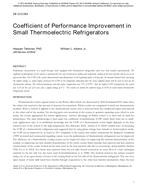The widespread use of computers for energy consumption calculations and heating/cooling load calculations warrants a reassessment of the various available mathematical methods that allow the inclusion in such calculations of the effects of the thermal mass of the exterior and interior components of the structure. Convenient methods for such calculations are needed in such diverse applications as the evaluation of the passive solar heating systems, the assessment of energy conservation measures and the de~ermination of the maximum load imposed on the heating/cooling equipment to be installed in a building.
The finite differences method of calculation is used frequently to solve the more complex dynamic problems in heat transfer that cannot be handled by analytical methods. The aim of the present paper is to provide the practicing engineer with the oasics of this inherently simple method and to show how it can be applied to heating and cooling calculations in a relatively simple way to account adequately for thermal storage effects.
A complete rigorous solution of the building heat flow problem using this mathematical method would be very complex, but when,certain simplifying assumptions are made, the problem can be reduced to an almost one-dimensional case
Product Details
- Published:
- 1977
- Number of Pages:
- 14
- File Size:
- 1 file , 900 KB
- Product Code(s):
- D-HA-2457
- Note:
- This product is unavailable in Russia, Belarus


